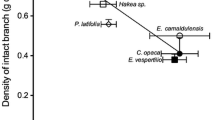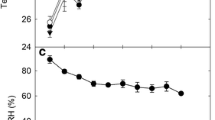Summary
The relationship of leaf biomass and leaf area to the conductive area of stems and branches was investigated in Picea abies. A total of 30 trees were harvested to determine if these relationships were different in different crown zones and in trees growing with and without competition for light. Two methods were compared. In the first, data were accumulated from crown zones situated at the top of trees to the bottom; in the second, data were used from individual crown zones. The results indicated that the latter method is much more sensitive in detecting differences in the relationship of leaf biomass or leaf area to conductive area. The analysis also indicated that ratios such as leaf area/sapwood area are frequently size-dependent. This size-dependency can in some cases result in the differences being abscured, but more often leads to the false impression that the relationship between the variables changes. The relationship between leaf biomass and leaf area and conductive area of stems or branches was different in different crown zones and under different growth conditions. The slopes of these regressions appear to increase with decreasing transpirational demand and decrease with increasing hydraulic conductivity. The intercepts are probably related to the amount of identified sapwood actually involved in water conductance.
Similar content being viewed by others
Reference
Albrektson A (1984) Sapwood basal area and needle mass of Scots Pine (Pinus sylvestris L.) trees in central Sweden. Forestry 57: 35–43
Ewers FW, Zimmermann MH (1984) The hydraulic architecture of eastern hemlock (Tsuga canadensis). Can J Bot 62: 940–946
Ewers FW, Zimmermann MH (1984) The hydraulic architecture of balsam fir (Abies balsamea). Physiol Plant 60: 453–458
Huber B (1928) Weitere quantitative Untersuchungen über das Wasserleitungssystem der Pflanzen. Jb Wiss Bot 67: 877–959
Ikeda T, Suzaki T (1984) Influence of pine-wood nematodes on hydraulic conductivity and water status in Pinus thunbergii. J Jpn For Soc 66: 412–420
Kaufmann MR, Troendle CA (1981) The relationship of leaf area and foliage biomass to sapwood conducting area in four subalpine forest tree species. For Sci 27: 477–486
Larsson S, Oren R, Waring RH, Barret JW (1983) Attacks of mountain pine beetle as related to tree vigor of ponderosa pine. For Sci 29: 395–402
Mitchell RG, Waring RH, Pitman GB (1983) Thinning lodgepole pine increases tree vigor and resistance to mountain pine beetle. For Sci 27: 204–211
Samson DA, Werk KS (1986) Size-dependent effects in the analysis of reproductive effort in plants. Am Nat 127: 667–680
Shinozaki KK, Yoda K, Hozumi K, Kira T (1964a) A quantitative analysis of plant form — the pipe model theory. I. Basic analyses. Jpn J Ecol 14: 97–105
Shinozaki KK, Yoda K, Hozumi K, Kira T (1964b) A quantitative analysis of plant form — the pipe model theory. II. Further evidence of the theory and its application in forest ecology. Jpn J Ecol 14: 133–139
Steel RGD, Torrie JH (1980) Principles and procedures of statistics. A biometrical approach. McGraw-Hill, New York
Tyree MT, Graham MED, Cooper KE, Bazos LJ (1983) The hydraulic architecture of Thuja occidentalis. Can Bot 61: 2105–2111
Waring RH, Pitman GB (1985) Modifying lodgepole pine stands to change susceptibility to mountain pine beetle. Ecology 66: 889–897
Waring RH, Gholz HL, Grier CC, Plummer ML (1977) Evaluating stem conducting tissue as an estimator of leaf area in four woody angiosperms. Can J Bot 55: 1474–1477
Waring RH, Newman HK, Bell J (1981) Efficiency of tree crowns and stemwood production at different canopy densities. Forestry 54: 15–23
Waring RH, Schroeder PE, Oren R (1982) Application of the pipe model theory to predict canopy leaf area. Can J For Res 12: 556–560
Whitehead D (1978) The estimation of foliage area from sapwood basal area in Scots pine. Forestry 51: 137–149
Whitehead D, Edwards WRN, Jarvis PG (1984) Conducting sapwood area, foliage area, and permeability in mature trees of Picea sitchensis and Pinus contorta. Can J For Res 14: 940–947
Zimmermann MH (1978) Hydraulic architecture of some diffuse-porus trees. Can J Bot 56: 2286–2295
Author information
Authors and Affiliations
Rights and permissions
About this article
Cite this article
Oren, R., Werk, K.S. & Schulze, ED. Relationships between foliage and conducting xylem in Picea abies (L.) Karst.. Trees 1, 61–69 (1986). https://doi.org/10.1007/BF00197026
Received:
Issue Date:
DOI: https://doi.org/10.1007/BF00197026




